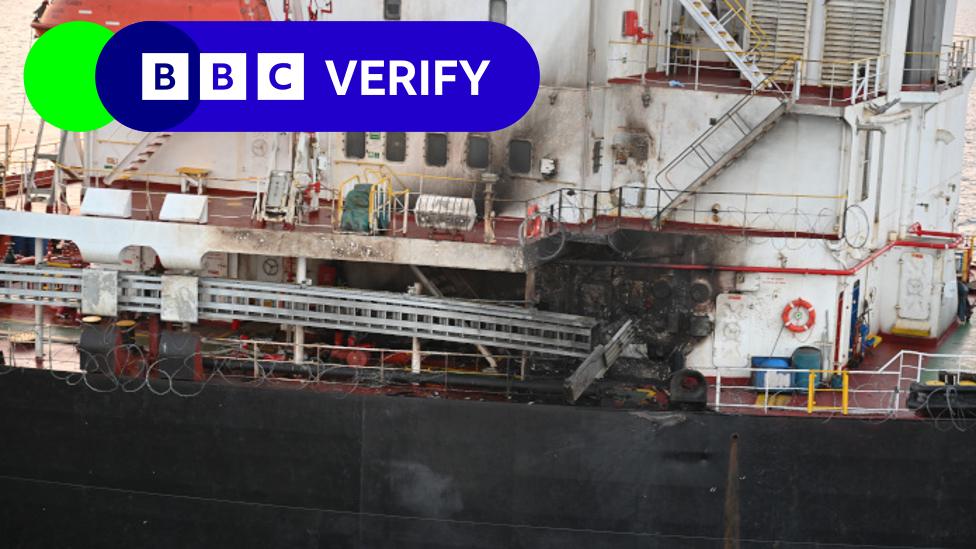US Navy aircraft carrier faces relentless battle against Houthi attacks
- Published
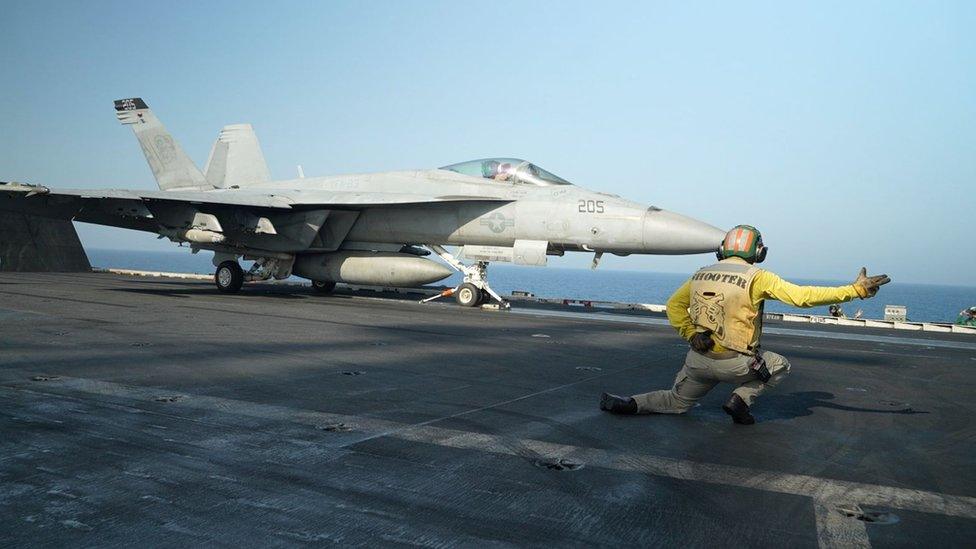
The USS Dwight D Eisenhower has been involved in strikes on Houthi targets in Yemen since January
It's not just merchant ships being targeted by the Houthis in the Red Sea. The US carrier strike group trying to protect them has also been under constant threat too.
The BBC is the first British media to visit the USS Dwight D Eisenhower since it began this mission in November.
"This is deadly stuff," says Captain Dave Wroe, who commands the four US Navy destroyers which provide the extra protection for the carrier.
It arrived soon after Yemen's Houthi's began to target merchant vessels - they say in response to Israel's assault on Gaza.
Captain Wroe lists the threats they've been facing over the past four months: anti-ship ballistic missiles, cruise missiles, unmanned aerial vehicles, unmanned surface vessels, and now unmanned underwater vessels, or UUVs, all loaded with explosives.
This is the most [attacks] since World War Two
UUVs are the latest threat. He says the F-18 jets on board the carrier have recently destroyed UUVs, before they could be launched.
Captain Wroe says the Houthis have posed the greatest challenge to the US Navy in recent history.
"This is the most since World War Two," he says. That was the last time the US operated in an area where they could be fired upon every day.
The tempo of operations on the aircraft carrier itself has also been unrelenting - with dozens of sorties being flown round the clock.
We watch as the deck crew direct the F-18s with luminous sticks, which they use to manoeuvre the jets round the flight deck at night.
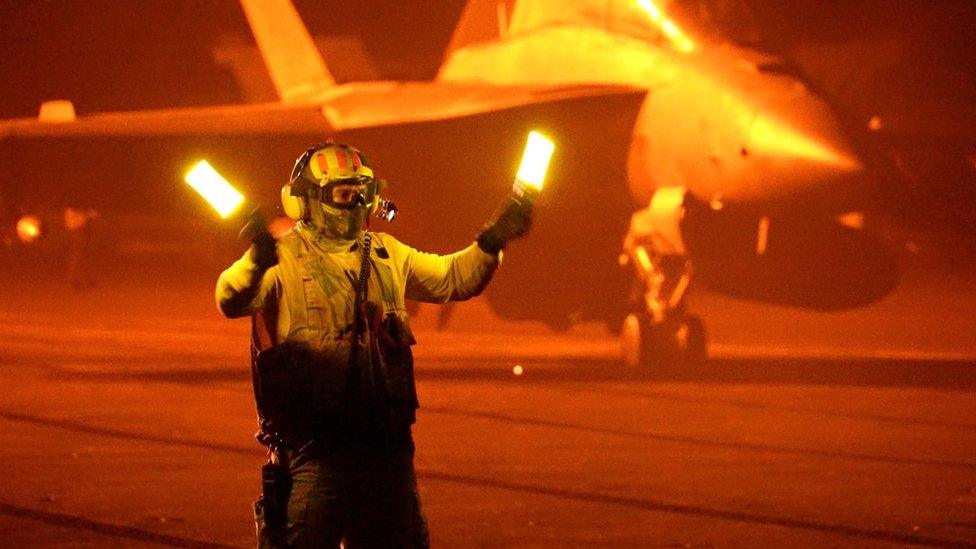
F-18 jets are carrying out sorties all day and night to try to stop Houthi attacks on merchant ships in the Red Sea
Up in the carrier's flight control tower, Commander George Zintac, known as the Air Boss, is having to choreograph their movements - with a jet either launching or landing in just over a minute.
He's been in the US Navy for more than 30 years, but says "this is probably the most flying I've done on a deployment - everyday we're flying a tonne".
In daylight you can see what they've been doing. On the side of each cockpit they've painted the silhouettes of the bombs they've dropped, the radar stations destroyed, and the drones they've shot down from the air. They've already fired more than 300 bombs and missiles.

Each jet has been painted with silhouettes, showing the number of bombs they've dropped
Row after row of more munitions are lined up in the hangar, ready for loading.
From the USS Eisenhower, or Ike as she's called by the crew, you can still see a few large merchant ships - tankers and bulk carriers sailing in the distance. But they're fewer in number.
Normally, the Red Sea carries around 20% of the world's maritime trade. It's the key route to Europe through the Suez Canal. It's less vital to America, but they're the ones doing the most to try to restore freedom of navigation.
But even with the presence of a US carrier strike group, the Red Sea remains extremely dangerous waters.
While we're on board we're told the Houthis have fired another ballistic missile, traveling at more than three times the speed of sound. The crews on the US destroyers have just minutes to track them and shoot them down. On this occasion it's well out of range and the missile falls into the water.
Others, though, have successfully hit merchant vessels. They've already struck several, sunk one - the Rubymar - and killed three crew on board the bulk carrier True Confidence.

The Rubymar cargo ship sank after being attacked by the Houthis in February
Rear Admiral Marc Miguez, the Carrier Strike Group commander, sees the signs of continuing sea trade as evidence their presence has had some success.
He believes strikes led by the US, with the help of Britain, have already degraded some of the Houthis' military capabilities. But it certainly hasn't deterred or stopped them.
Rear Admiral Miguez believes the Houthis are not acting on their own.
"Iran is backing the Houthis right now, not only with weapons and technology, but also providing targeting information intelligence and support," he says.
I ask why then is the US not also targeting Iran? "That's a policy decision," he says, "but the roots of this start with Iran."
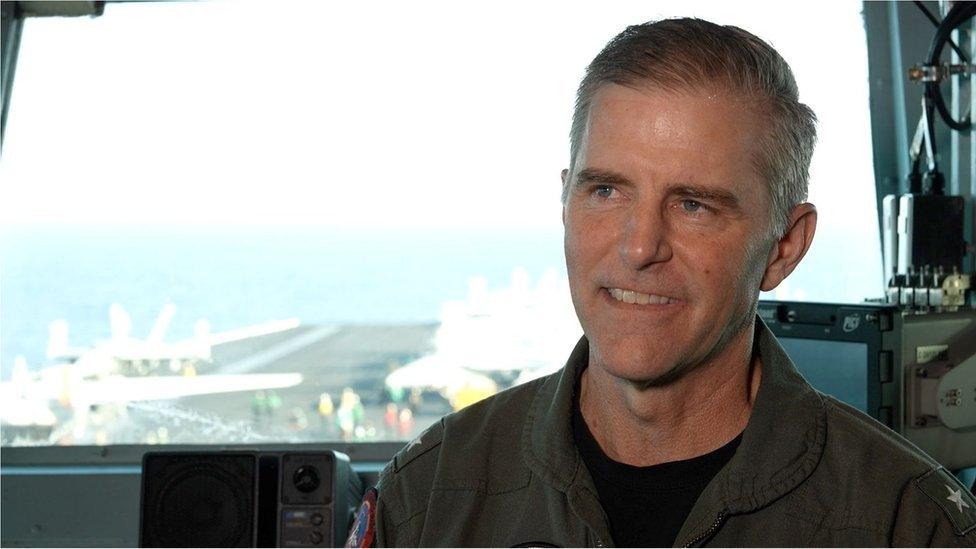
Rear Admiral Marc Miguez, the Carrier Strike Group commander, says they will stay "as long as we're needed"
In reality, US President Joe Biden does not want to spark a wider Middle East conflict, particularly in an election year.
Admiral Miguez says they'll stay for "as long as we're needed".
But there are limits to sustaining this level of military presence.
Unlike the Houthis, they're away from home with few creature comforts. Every meal on board is literally feeding the five thousand. The food bill on the carrier alone is $2m (£1.6m) a month.
Captain Chris Hill, the commanding officer of Ike, says "people need breaks, they need to go home".
But he says they don't yet have dates for when that'll happen. So one of his tasks is to maintain the crews morale and resilience.
He even has a dog on board to help. Demo, a facility dog who's been trained for life on the carrier, walks the mess decks to help lift the crew's spirits.
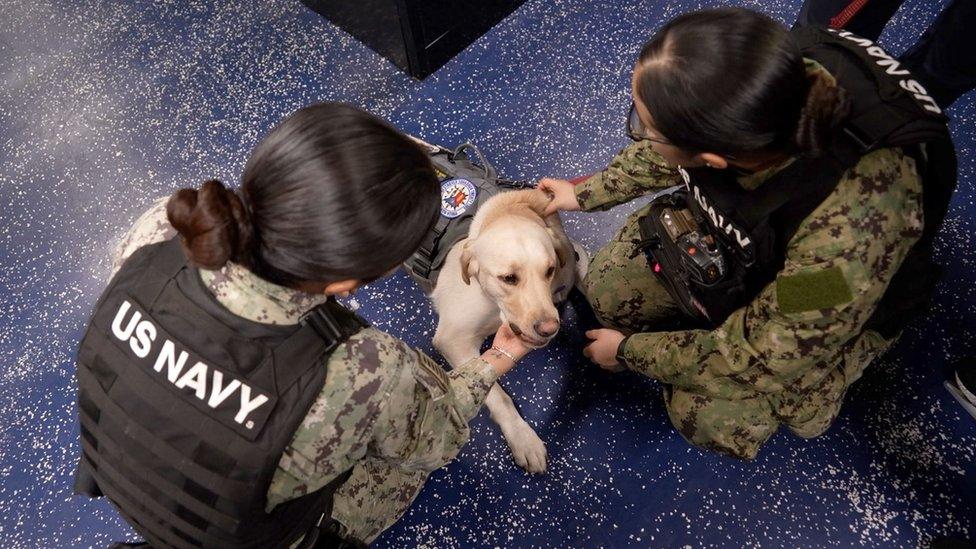
Demo the dog has been brought on board to boost the morale of crew members who have spent months at sea
He's not short of affection and Captain Hill says Demo has helped reduce some of the stress of being away for months on end. Most of the crew rarely see daylight.
But as for the USS Dwight D Eisenhower's main mission, it's still too early to judge what lasting effect it'll have achieved.
Captain Hill says: "It's difficult to define winning and losing in this kind of conflict."
"Ideally, we want to stop every Houthi attack."
When I ask whether that's achievable, he replies that it's "hard to say".
He suggests it will also require wider government and international efforts. In short, it'll take more than a powerful US carrier strike group to resolve this crisis.
Related topics
- Published25 March

- Published12 January 2024

- Published20 January 2024
